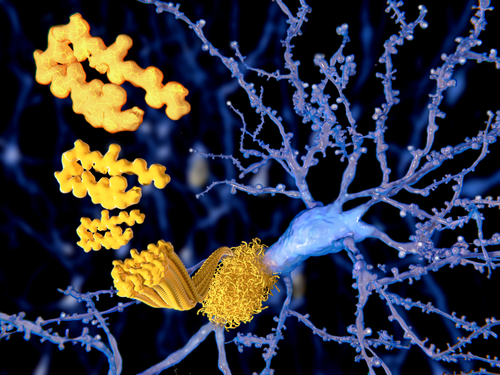New Compound Can Prevent Formation of Toxic Alpha-Synuclein Aggregates, Animal Study Finds

A newly identified small molecule compound, called SynuClean-D, can prevent the formation of toxic alpha-synuclein aggregates, disrupt the propagation of amyloid fibrils, and rescue nerve cells from alpha-synuclein-induced death in an animal model of Parkinson’s disease, a study shows.
Given this particular activity, SynuClean-D may be a promising candidate for the development of new Parkinson’s therapies.
The study, “Small molecule inhibits α-synuclein aggregation, disrupts amyloid fibrils, and prevents degeneration of dopaminergic neurons,” was published in the Proceedings of the National Academy of Sciences.
The process of amyloid aggregation that characterizes several neurodegenerative disorders can be simulated in the laboratory. This strategy can be used to identify and test potential therapies. However, fibril growth occurs very slowly in a highly variable manner, which can make targeted-compound screening a difficult process.
A team led by researchers at the Universitat Autònoma de Barcelona implemented a robust high-throughput assay that allows the screening of large chemical libraries in search of inhibitors that can specifically prevent alpha-synuclein aggregation.
This assay detects a compound called thioflavin-T, or Th-T, which binds to amyloid proteins and gives a strong fluorescent signal that works as a readout of amyloid formation. The team used this new method to screen about 14,400 chemical compounds in the HitFinder Collection from Maybridge, a platform with a wide portfolio of chemistry products and services specifically tailored to the drug discovery and biotechnology sectors.
Want to learn more about the latest research in Parkinson’s Disease? Ask your questions in our research forum.
Through this analysis, researchers identified the small molecule SynuClean-D as an attractive potential inhibitor of alpha-synuclein.
The compound could actively prevent alpha-synuclein aggregation in laboratory cells, with a reduction of Th-T levels between 34% and 58%, depending on the dose used. SynuClean-D could also reduce the amount of Th-T-positive aggregates in cells carrying the genetic mutations H50Q and A30P in the alpha-synuclein gene, which are associated with familial Parkinson’s disease.
Using a Caenorhabditis elegans worm model of Parkinson’s disease, the team found that treated animals had significantly fewer visible alpha-synuclein aggregates than untreated animals. In some worms, the treatment even resulted in a near-complete loss of protein aggregates.
“SynuClean-D is a nontoxic molecule that exhibits a unique capability to interact with and disassemble amyloid fibrils,” the researchers wrote.
Further analysis revealed that about 44% of treated animals retained all their dopamine-producing nerve cells alive, in contrast to only 14% of the untreated animals.
According to the researchers, these results “evidenced the ability of SynuClean-D to protect against alpha-synuclein–induced dopaminergic neuron degeneration,” a hallmark feature of Parkinson’s disease.
“Everything seems to indicate that the molecule we identified, the SynuClean-D, may provide therapeutic applications for the treatment of neurodegenerative diseases such as Parkinson’s in the future,” Salvador Ventura, PhD, a researcher at Universitat Autònoma de Barcelona and senior author of the study, said in a press release.






